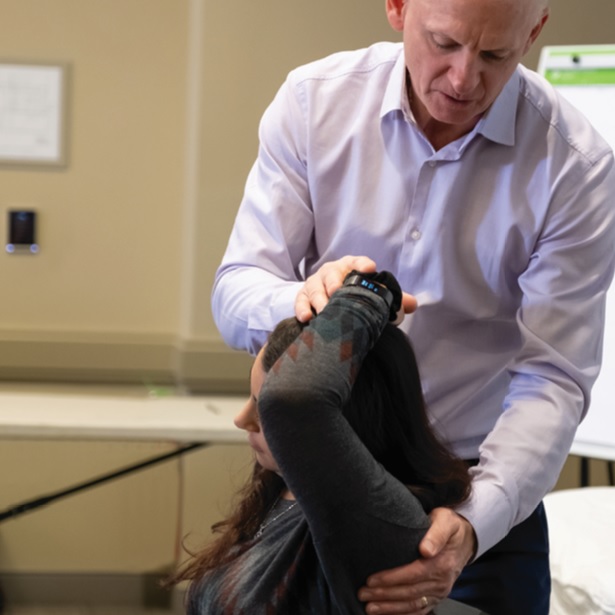News Room
Mechanical Diagnosis and Therapy® Helps Uncover Causes Hiding in the Spine
 Kevin Jones agrees wholeheartedly with the old adage that you can't judge a book by its cover.
Kevin Jones agrees wholeheartedly with the old adage that you can't judge a book by its cover.
On the whole, most musculoskeletal pain is manageable conservatively. In fact, 92 percent of all musculoskeletal pain is mechanical in nature, and 82 percent of these are rapidly reversible. Only 5 to 8 percent of the musculoskeletal cases Jones, PT, Dip. MDT and his peers see at the Integrated Musculoskeletal Care (IMC) need their care escalated.
More specifically, and interestingly, 20 to 30 percent of what appear to be peripheral joint conditions actually originate in the cervical, thoracic or lumbar spine. A newly published study1 by Richard Rosedale, PT, Dip. MDT estimates over 40 percent of peripheral joint problems have a spinal influence.
The clinicians at IMC fortunately manage peripheral joint and spinal conditions equally well using McKenzie Method® of Mechanical Diagnosis and Therapy® (MDT) principles, which essentially allow Jones to treat conditions where others have been unsuccessful.
IMC contracts with large companies and some clients have MRI pre-certification rules in place, putting Jones in a gatekeeper role. He’s often the one who confirms whether physical therapy is the better rehab option compared to having an MRI or surgery.
“When patients are forced to come to us before they can get an MRI or surgery, some are unhappy because of a belief system that only MRIs or surgery will fix their problem," Jones says. "Once the patient starts to see improvement conservatively, through the cause-and-effect responses of the MDT evaluation, their attitude changes.
“I am able to quickly determine whether or not they have the ability to get better conservatively,” he explains. “If they are able to improve conservatively, then most do not see the need of escalating care with an MRI or other advanced imaging.”
They may even discover that they are seeking solutions to the wrong problem. In fact, IMC data shows some 18 percent of MRIs are ordered for the wrong body part.
The mechanical evaluation he uses typically reveals an overlooked source of the pain. Jones estimates more than 70 percent of the musculoskeletal conditions he sees are rapidly reversible, meaning there is a significant capacity for positive change to occur quickly and MDT clinicians can classify this as a Derangement.
These Derangements can be easy to miss, especially if an MRI appears to establish a cause, Jones says. For example, an image might suggest a rotator cuff tear is instigating shoulder pain when, after a thorough MDT examination, it is found that the cervical spine is influencing the shoulder. The Rosedale study2 found that nearly 30 percent of shoulder pain he observed was resolved by spinal intervention.*
“All of this evidence confirms what we’ve found at IMC,” Jones said. “With every peripheral joint patient we see, we assess the spine to rule in or rule out any spinal influence.
"We know there are a lot of false positives with MRIs. It's an automatic assumption that an MRI is the answer," Jones says. "MRIs are very sensitive. They pick up everything. So, it may not be the thing."
MRI images also don't tell physicians or PTs whether someone can get better without surgical or medical intervention. That takes an in-depth examination and evaluation that Jones depends on the McKenzie Method to provide.
"A thoroughly trained MDT clinician isn't just evaluating the shoulder," Jones says. "They are going to be looking at anything that could be influencing the pain."
The evidence-based MDT system begins with a thorough mechanical evaluation to establish a "cause-and-effect" relationship between historical pain behavior as well as the response to repeated test movements, positions and activities.
A systematic progression of applied mechanical forces utilizes pain response to monitor changes in motion and function to classify the disorder. Clinicians then develop a specific plan of care based on the examination results that empowers patients to treat themselves when possible.
"MDT is a reliable diagnostic process and it's efficient," Jones says. "We know within two or three visits if we can help you or not."
So, not only does he impress patients by sparing them the cost and recovery time associated with surgery, injections and the like, he's able to do it quickly and effectively. The true challenge for Jones seems to be shifting conventional preference from machine to mechanical diagnosis.
“MDT in its truest sense is a thorough process of examination and evaluation," he says. "When we look at a problem, we consistently consider all of the possible causes for the pain and loss of function, and then allow the cause and effect examination of the related spine and the offended joint to determine the best course of action.”
Just as lost items always seem to be in the last place you look, the impetus of an impairment isn't always apparent. There's plenty of pain that can't be treated if you don't look beyond the proverbial cover.
1 Rosedale R et al. (2019). A study exploring the prevalence of Extremity Pain of Spinal Source (EXPOSS). The Journal of Manual & Manipulative Therapy, published online: 02 Sep 2019.
2 Heidar Abady, A., Rosedale, R., Chesworth, B. M., Rotondi, M. A., & Overend, T. J. (2017). Application of the McKenzie system of Mechanical Diagnosis and Therapy (MDT) in patients with shoulder pain; a prospective longitudinal study. The Journal of Manual & Manipulative Therapy, 25(5), 235-243.
Share your news! Send your story to us and we'll post it for everyone to read.




